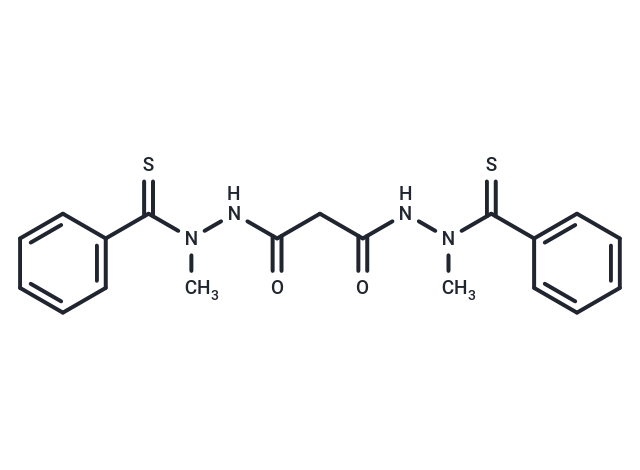Shopping Cart
Remove All Your shopping cart is currently empty
Your shopping cart is currently empty
Elesclomol (STA-4783) is an oxidative stress inducer and a highly lipophilic copper ion carrier. Elesclomol induces apoptosis in tumor cells and is used in copper death related studies. Elesclomol also inhibits FDX1-mediated Fe-S cluster biosynthesis.

| Pack Size | Price | USA Warehouse | Global Warehouse | Quantity |
|---|---|---|---|---|
| 5 mg | $34 | In Stock | In Stock | |
| 10 mg | $59 | In Stock | In Stock | |
| 25 mg | $93 | In Stock | In Stock | |
| 50 mg | $128 | In Stock | In Stock | |
| 100 mg | $163 | In Stock | In Stock | |
| 200 mg | $243 | In Stock | In Stock | |
| 1 mL x 10 mM (in DMSO) | $39 | In Stock | In Stock |
| Description | Elesclomol (STA-4783) is an oxidative stress inducer and a highly lipophilic copper ion carrier. Elesclomol induces apoptosis in tumor cells and is used in copper death related studies. Elesclomol also inhibits FDX1-mediated Fe-S cluster biosynthesis. |
| Targets&IC50 | HL-60 cells:9 nM, Ramos cells:0.02 μM (EC50), MCF-7 cells:0.024 μM, SK-MEL-5 cells:0.11 μM |
| In vitro | In nude mouse models carrying human breast cancer (MDA435, MCF7, and ZR-75-1), lung cancer (RER), or lymphoma (U937), Elesclomol ([25-100 mg/kg]) alone demonstrated no anticancer activity. However, it significantly enhanced the efficacy of chemotherapeutic agents such as paclitaxel, leading to tumor regression and extended lifespan in mice. |
| In vivo | Elesclomol exhibits significant inhibitory effects on the viability of SK-MEL-5, MCF-7, and HL-60 cells with IC50 values of 110, 24, and 9 nM, respectively. It induces the production of copper-dependent reactive oxygen species (ROS) and toxicity in yeast cells not by targeting specific intracellular sites but through interaction with the electron transport chain, which leads to elevated levels of ROS in organelles and consequently, cell death. Furthermore, treatment with 100 nM Elesclomol significantly induces the expression of heat shock response genes and metallothionein genes in Hs294T cells as analyzed through Affymetrix gene chip at 6 hours post-treatment. In Ramos Burkitt's lymphoma B cells treated with 100 nM Elesclomol, Hsp70 RNA levels increase by 4.8-fold and 160-fold after 1 and 6 hours, respectively. Additionally, ROS levels rise by 20% and 385% after 0.5 and 6 hours of treatment, with antioxidant pretreatments like N-acetylcysteine and Tiron inhibiting the induction of Hsp70. Treatment with 200 nM Elesclomol for 18 hours increases early and late apoptosis in HSB2 cells by 3.7 and 11 times, respectively, through the induction of oxidative stress. |
| Kinase Assay | In vitro enzyme assays for PLK1: Recombinant PLK1 (10 ng) is incubated with different concentrations of Rigosertib in a 15 μL reaction mixture (50 mM HEPES, 10 mM MgCl2, 1 mM EDTA, 2 mM Dithiothreitol, 0.01% NP-40 [pH 7.5]) for 30 min at room temperature. Kinase reactions are performed for 20 min at 30 °C in a volume of 20 μL (15 μL enzyme + inhibitor, 2 μL 1 mM ATP), 2 μL of γ32P-ATP (40 μCi), and 1 μL of recombinant Cdc25C (100 ng) or casein (1 μg) substrates. Reactions are terminated by boiling for 2 min in 20 μL of 2× Laemmli buffer. Phosphorylated substrates are separated by 18% SDS-PAGE. The gels are dried and exposed to X-ray film for 3-10 min. |
| Cell Research | Cells are treated with various concentrations of Elesclomol for 18 or 24 hours. The level of intracellular ROS is monitored using the DCFDA probe, which emits a green fluorescence on oxidation. Cell death is determined by flow cytometry of cells double stained with Annexin V/FITC and propidium iodide (PI) using a Vybrant Apoptosis assay kit.(Only for Reference) |
| Synonyms | STA-4783 |
| Molecular Weight | 400.52 |
| Formula | C19H20N4O2S2 |
| Cas No. | 488832-69-5 |
| Smiles | CN(NC(=O)CC(=O)NN(C)C(=S)c1ccccc1)C(=S)c1ccccc1 |
| Relative Density. | 1.313 g/cm3 |
| Color | Yellow |
| Appearance | Solid |
| Storage | store at low temperature | Powder: -20°C for 3 years | In solvent: -80°C for 1 year | Shipping with blue ice/Shipping at ambient temperature. | ||||||||||||||||||||
| Solubility Information | 2% DMSO+40% PEG300+5% Tween 80+ 53% Saline: 5 mg/mL (12.48 mM), Sonication is recommended, DMSO: 250 mg/mL (624.19 mM), Sonication is recommended. Ethanol: < 1 mg/mL (insoluble or slightly soluble) | ||||||||||||||||||||
| In Vivo Formulation | 10% DMSO+40% PEG300+5% Tween 80+45% Saline: 7.4 mg/mL (18.48 mM), Solution. Please add the solvents sequentially, clarifying the solution as much as possible before adding the next one. Dissolve by heating and/or sonication if necessary. Working solution is recommended to be prepared and used immediately. The formulation provided above is for reference purposes only. In vivo formulations may vary and should be modified based on specific experimental conditions. | ||||||||||||||||||||
Solution Preparation Table | |||||||||||||||||||||
DMSO
| |||||||||||||||||||||
| Size | Quantity | Unit Price | Amount | Operation |
|---|

Copyright © 2015-2025 TargetMol Chemicals Inc. All Rights Reserved.